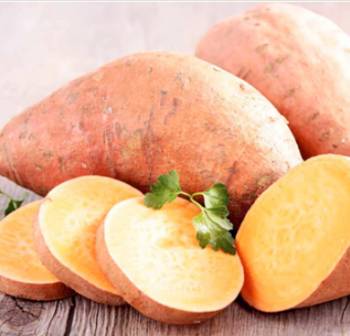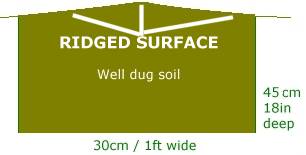GROWING SWEET POTATOES IN THE UK
Article by David Marks
Sweet potatoes are native to the sub-tropics and grow best in temperatures above 70°F / 20°C and in humid conditions. However, a couple of varieties have been bred to survive the UK climate and with our hints and tips on growing them you can expect a reasonable crop in many parts of the UK
To navigate around this article click the “DETAILED MENU” button above.
SWEET POTATO SLIPS OR CUTINGS
The majority of sweet potatoes are started from “slips”. These are green shoots which have grown from the tuber and then been removed. They have no (or very tiny) root systems which means they take some time to establish themselves.
Suttons Seeds however developed a new technique in 2014 so that they can sell rooted cuttings of sweet potatoes which grow much quicker and more reliably, especially important in the cool UK climate. See the list of varieties below for more details.
BEST VARIETIES OF SWEET POTATO
The variety of sweet potato you choose to grow in the UK is very important. Varieties which are grown in warmer parts of the world will simply not tolerate our cooler temperatures. Attempting to grow sweet potatoes from those sold at supermarkets for eating is likely to be doomed to failure in all but the very warmest parts of the UK. Frequently the varieties used are only suited to much warmer climates.
Below we list the main varieties of sweet potatoes which grow well in UK conditions.
BEAUREGARD SWEET POTATO VARIETY
The most commonly grown variety in the UK and it performs well as an all-rounder. It doesn’t produce the largest crop but it reliably grows lots of sweet, orange coloured tubers. This is the one we would recommend for most garden / allotment situations. Note that some companies call this Beauregard Improved whilst others call it simply Beauregard. Both are the same variety.

This variety is sometimes sold by the supermarkets and therefore the nearest you will get to the flavour, colour and texture of the sweet potato most of us know.
Slips of Beauregard are sold by most of the seed companies and at larger garden centres. If you want to buy the more vigorous potted cuttings then they can be bought from
Suttons here.
GEORGIA JET SWEET POTATO VARIETY
Several online articles still recommend Georgia Jet as the best variety to grow in the UK. We don’t agree with for two key reasons. Firstly, it is almost impossible to get hold of in the UK, a significant disadvantage for those wanting to buy here!
The second reason is that more recently introduced varieties are more reliable for growing in the UK, see those listed above and below.
BONITA SWEET POTATO VARIETY
If you want something slightly different to the supermarket type sweet potatoes then try Bonita. The flesh is sweet and white and the skins are light brown.You can buy the vigorous potted cuttings here.
GROWING CALENDAR SWEET POTATOES
The calendar below is correct for Change town here.

BEST GROWING CONDITIONS FOR SWEET POTATOES
Sweet Potatoes are a sub-tropical (nearly tropical crop) so they do best in
warm and humid conditions, not something which naturally occurs in the UK.
We describe below the best conditions which be provided for sweet potatoes
in the UK. Aim for those conditions but accept that in the UK this will
not be fully possible.
BEST TEMPERATURES FOR SWEET POTATOES
Sweet potatoes grow best in a daytime temperature range of
26°C to 28°C (79°F to 82°F) however in the UK this is not
achievable. If you have a polytunnel or space in a greenhouse then that's
the best option. Covering with cloches also works well especially if the
cloches are put in place a month or more before you plant out.
The next best help is to cover the ground with black plastic mulch which can be bought from garden centres or online. The black plastic will help the soil surface warm up and at the same time reduce water evaporation, both good for growing sweet potatoes. You will need to remove the black plastic when planting sweet potatoes because they grow their tubers where the stems touch the ground.
In many parts of the UK you will still get a crop of sweet potatoes when grown directly in the ground. It's just that the warmer the conditions the larger the crop will be so don't be put off trying crop if your area doesn't have ideal conditions.
OTHER CONDITIONS FOR SWEET POTATOES
The best soil for sweet potatoes is light, well dug, good drainage, reasonably fertile but not too much nitrogen. Excess nitrogen will promote lots of leafy growth at the expense of the size of the tubers.
The ideal would be to plant the slips / cuttings in a mounded bed, similar to that recommended for ridge cucumbers. See the picture below.

The ridge on the soil helps greatly with drainage and at the same time the shape causes the soil to warm it up quicker compared to flat ground. The ground should be kept moist moist but not water-logged.
PLANTING SWEET POTATO SLIPS
Sweet potatoes are very susceptible to frost damage and low temperatures in general. To grow them successfully they must be planted out in the open ground when temperatures are high enough to encourage vigorous growth and also as early in the season as possible. At the same time avoid all exposure to frost and low temperatures. We recommend planting them out in the first to second week of June 2017 (average for UK).
When you get your sweet potato slips at home the first thing to do is to unpack them carefully, they are fragile and easily damaged. Unpack as soon as you receive them in the post or get them home from the garden centre.
If the slips have been bought online and delivered through the post it's best to place them in a glass with 5cm / 2in of lukewarm water in it. Leave them there overnight to absorb water.
Then, for all slips, plant each one in its own individual pot of multi-purpose compost - 8cm wide pots will do fine initially. Make sure the compost is moist. The slips need to be planted in the compost up to the lowest set of leaves.
Place the pots in a light position where it will keep warm but avoid direct sunlight during the middle of the day. Make sure the compost in the pots doesn't dry out.
Before planting them out in the open, harden them off for a week, gradually increasing their time outside. Plant them outside to the same depth as they are in the pots. They should be spaced 30 cm / 12in apart and rows should be 80cm / 32ins apart.
On most soils sweet potatoes will not need feeding. If the soil is poor add a handful of blood, fish and bone per plant every month. Don't add any nitrogen rich fertiliser, that will simply encourage the growth of foliage and not the tubers. Keep the ground moist but not water-logged.
Don't be in a rush to harvest sweet potatoes, the longer they are in frost free ground the larger the tubers will grow.
The foliage of the plants tends to spread out a lot and it's best to pinch out the growing tips when the stems reach 60cm / 2ft long to keep them tidy and encourage side shoots.
HARVESTING SWEET POTATOES
Sweet potatoes should be harvested as late as possible because they don't store well in UK conditions (see below for more information) and they also form larger tubers when left in the ground longer. If possible harvest them a week or two before the first frosts or when the foliage has died down. We recommend harvesting in the second week of October 2017 (average for UK).
Use a fork to harvest them, digging around the growing area to locate the tubers. Some varieties will produce thier tubers near the main stem whilst others can produce tubers 30cm / 1ft or more away. Handle them carefully because they bruise easily.
In their natural, tropical conditions they do store well but they don’t store well after harvest in UK conditions so eat them within a couple of days of harvest. If you have a heated greenhouse they can be stored there for longer.
PESTS AND DISEASES OF SWEET POTATOES
Sweet potatoes suffer very few problems when grown in the UK. If you find that the tubers are smaller than expected this is probably caused by lack of warmth. They also don’t appreciate waterlogged conditions which can cause rotting of the tubers. To avoid this ensure the ground is well drained.
If you are growing them in a greenhouse or polytunnel, whitefly can be a problem. Either spray with an appropriate insecticide or use the parasite wasp Encarsia formosa to keep the whitefly numbers down in greenhouses / polytunnels. These are sold in packs of 500 at some garden centres. You can also
buy them online for immediate delivery by
clicking here.